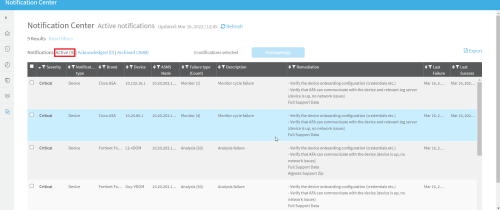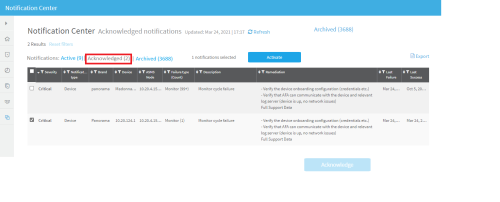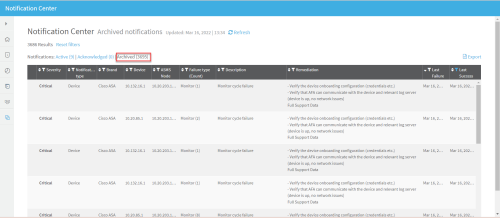Manage ASMS notifications
The ASMS Notification Center notifies you about problems, both actual and potential, across ASMS.
Each notification displayed provides details of the issue and the information needed to solve the problem.
These notifications refer to:
- System issues such as dwindling disk space.
- Device specific issues such as a failed analysis.
Manage ASMS from the Notification Center
Do the following:
-
In AFA, FireFlow, or AppViz, click Notification Center on the toolbar. The Notification Center opens on the Active tab displaying the Active Notifications list.
Each active notification is displayed as an entry in the table. For more details, see Notifications Center column reference.
Note: Critical system Notifications are displayed in red to distinguish them from device-specific Notifications.
-
Do any of the following:
-
To sort the notifications by column, click
 in the column header.
in the column header.
-
To filter the notifications by column, click
 in the column header, and type the search in the text box.
in the column header, and type the search in the text box. -
To reset all sorting and filtering, click Reset filters.
| Explore solutions | To explore solutions for an issue, see the suggestions in the Remediation column. |
| Sort and filter |
By default, the list is sorted first by Severity and then by Issue type. Sort and filter the table as follows: |
| Export | To export one or more active notifications to a CSV file, select the notification(s) in the list, and click |
| Acknowledge notifications |
To remove one or more notifications from the Active Notifications list (even though the issue has not been resolved), select the notification(s) and click Acknowledge.
Note: Only selected specified notifications are marked as acknowledged; related notifications are unaffected. For more details, see Acknowledged Notifications. |
Acknowledged Notifications
Acknowledged Notifications are items that have been manually removed from the Active Notifications list even though they have not been fully resolved.
View acknowledged notifications to check their details, or reactivate them to move them back to the Active Notifications list.
Do the following:
-
To view the Acknowledged Notifications list, click the Acknowledged Notifications tab.
The list of acknowledged Notifications is displayed.
The Acknowledged Notifications list supports the same filtering, sorting, and exporting functionality as the Active Notifications.
-
To re-activate one or more acknowledged notifications, select the notification(s) and click Activate.
The notification(s) move(s) from the Acknowledged Notifications list to the Active Notifications list.
-
To return to the Active Notifications list, click the Active tab.
The Active Notifications list is displayed.
- To refresh the Notifications Center, click
 .
.
Archived Notifications
Notifications are automatically moved to the archive as their issues are resolved. There is no way of manually adding issues to or deleting issues from the archive. The archive lets users check past occurrences of resolved issues.
To display the Archived Notifications list, click the Archived tab.
The Archived Notifications list supports the same filtering, sorting, and exporting functionality as the Active Notifications list does.
Notifications Center column reference
| Column | Description |
|---|---|
| Severity | Severity level of the Notification. Severity levels include: Low, Medium, High and Critical. |
|
Notification Type |
One of the following Notification types: System or Device. System notifications refer to system issues, such as failed backups or available disk space. Device notifications refer to device issues, such as failed analysis or log collection. Critical system notifications are displayed in the list in red to easily discern them from device specific notifications. |
|
Brand |
Brand of the device with the Notification. This field is only relevant for device notifications. |
|
Device |
Name of the device with the Notification. This field is only relevant for device notifications. |
|
ASMS Node |
The name of node with the Notificationand its role. This is relevant when a distribution architecture is enabled; otherwise, this will always be the localhost/master. |
|
Failure Type (Count) |
The type of failure that occurred and the number of times it occurred. |
|
Description |
A description of the Notification issue. |
|
Remediation |
Information to solve the problem. |
|
Last Failure |
Date and time of the last failure. |
|
Last Success |
The date and time of the last successful completion of the task. |




